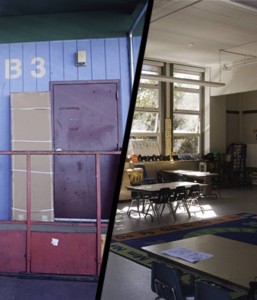Over 50 SFUSD schools to finish repairs if ballot initiative passes
The final bond, which would cost property owners up to $21 for every $100,000 of assessed value, would complete the work of seismically retrofitting, providing handicapped accessibility and creating state-of-the-art facilities for the SFUSD’s nearly 60,000 preschool through high school students.
While students are benefiting from new computers and electronics, they’re also enjoying eco-friendly improvements like rainwater collection and schoolyards with gardens. Galileo High School and Washington High School now have professional football fields, while other schools like Cobb Elementary are enjoying entire makeovers.
“I can’t believe how beautiful the school is,” said Yvette Fagan, a teacher at Cobb Elementary. Fagan’s once classroom featured peeling paint, poor flooring and an antique green chalkboard that turned black after nearly a century of use.
Now green tiles adorn the hallways and playgrounds have been repainted, creating a “modern” environment that administrators praise as inviting a greater sense of community and pride for their school. District administrators say modernity leads to better academic performance and a more uplifting environment.
“Fifth graders have become role models to the little kids,” said Fagan. “At the end of lunch, all the kids come together to pick up trash.”
A new middle school in the Silver Terrace district will be constructed on land designated to replace Martin Luther King Jr. Middle School. And aging schools like historic Cesar Chavez Elementary will have upgraded security systems to monitor children wandering near doorways, greater wireless connectivity, improved accessibility for mothers with strollers, and the replacement of missing ceiling tiles and soiled rugs.
“It’s a beautiful, wonderful school, but it’s an ancient school,” said Catalina Rico, principal of Cesar Chavez Elementary.
The project on a grander scope hasn’t been particularly splashy or heavily noted.
“It’s been a quiet story,” said Deputy Superintendent Myong Leigh, of the little attention given to the project. “But the breadth of the improvement has been a massive effort.”
“When buildings aren’t renovated, they show their age. If you have a depressing environment, it’ll show,” said Leigh.
With test scores increasing, achievements gaps narrowing and applications increasing, the district is optimistic of the effects such upgrades will have on their current and prospective students.
The massive redevelopment of the school district aims to attract families to a city that has experienced a decline in families since the 1960’s.
“There is more curb appeal. The impression is a game-changer. It makes public schooling an attractive option,” said Leigh.
QUICK FACTS: Show me the money!
60,000————-Number of K-12 students that would benefit from the bond.

